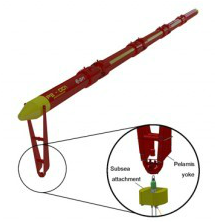Installation
The installation operations have a significant impact on the costs of every offshore project, although in the case of floating wave devices, it can be reduced by means of some design changes. Generally, every installation strategy can be classified in these groups:
However, installation strategies and costs totally depend the specific device used, although there are also some similiarities. Most of the installation costs are absorbed by the rental of suitable vessels. There are different ways of achieving cost reduction. On the one hand, minimising the installation costs is maximising the weather window during which installation is possible. When installation cannot be performed because the conditions are not favourable, extra mobilisation costs and project delays need to be added to the overall project cost. Therefore, it can be useful to use a higher cost vessel that can operate in a wider range of sea conditions. Remotely operated vehicles (ROV) are a possible solution that permit operating in adverse weather conditions and at the same time reduce dramatically the risk of the crew as no humans are on board.
On the other hand, the main cost reduction opportunity resides in the use of non-specialist vessel. Tugs and other non-specialist vessels are widely available and can be chartered at less cost, whereas specialist vessel are much more expensive and harder to hire. Generally the more specialised the vessel, the greater costs.
The option of the vessel depends on the device, as some devices can be towed to the site by using a tug and their anchors placed using an anchor-handling vessel, while others need to be carried on a heavy-lift vessels or a barge. Pelamis Wave Power developed a skid winch and “plug and play” kind of component that allow pulling the device by a tug to the site, allowing the use of a cheaper vessel and reducing the installation time.
- Installation of subsea cables and grid interconnection,
- Installation of the mooring systems,
- Installation of the device.
However, installation strategies and costs totally depend the specific device used, although there are also some similiarities. Most of the installation costs are absorbed by the rental of suitable vessels. There are different ways of achieving cost reduction. On the one hand, minimising the installation costs is maximising the weather window during which installation is possible. When installation cannot be performed because the conditions are not favourable, extra mobilisation costs and project delays need to be added to the overall project cost. Therefore, it can be useful to use a higher cost vessel that can operate in a wider range of sea conditions. Remotely operated vehicles (ROV) are a possible solution that permit operating in adverse weather conditions and at the same time reduce dramatically the risk of the crew as no humans are on board.
On the other hand, the main cost reduction opportunity resides in the use of non-specialist vessel. Tugs and other non-specialist vessels are widely available and can be chartered at less cost, whereas specialist vessel are much more expensive and harder to hire. Generally the more specialised the vessel, the greater costs.
The option of the vessel depends on the device, as some devices can be towed to the site by using a tug and their anchors placed using an anchor-handling vessel, while others need to be carried on a heavy-lift vessels or a barge. Pelamis Wave Power developed a skid winch and “plug and play” kind of component that allow pulling the device by a tug to the site, allowing the use of a cheaper vessel and reducing the installation time.
Another possibility for reducing installation costs is the development of detachable components that enable the installation of the device by parts rather than having to lift it by specialised vessels. This is also an opportunity to reduce operation and maintenance costs, as it allows components to be detached and brought to shore if repair is required. So here the key is to design devices than can be divided easily into different pieces but that are still robust enough to the sea environment.


